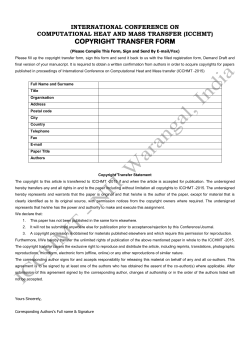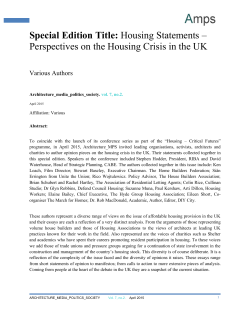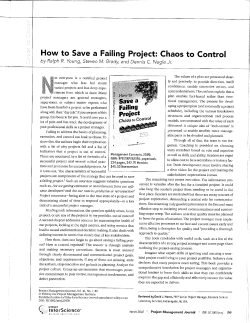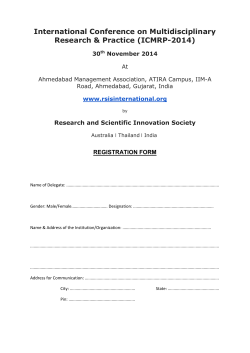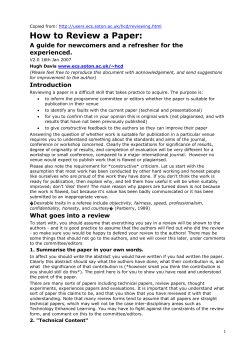
Details - The University of Chicago Booth School of Business
Policies, Requirements, and Advice for Authors 52nd Annual (2017) Journal of Accounting Research Conference Registered Reports of Empirical Research 1. Introduction The 2017 Journal of Accounting Research Conference is devoted to Registered Reports. This document describes the Registration-based Editorial Process (REP) that will be used to select articles for the 2017 Conference. Section 2 discusses the nature of REP, which will help authors and reviewers understand how it differs from the traditional editorial process. Section 3 describes the standards for evaluating proposals and reports. Section 4 presents the editorial policies for the conference, and the required elements of proposals and reports. Section 5 provides advice to help authors submit strong proposals. 2. The Registration-based Editorial Process (REP) The Registration-based Editorial Process (REP) seeks to increase the supply of high-quality research projects by using two stages of evaluation. In the first stage, the authors submit a proposal for gathering and analyzing data. In the second stage, the authors submit a report on the results of their efforts. REP operates as follows. Editors determine whether the initial proposal submission is promising enough to be sent to one or more referees for review, and if so, use the review(s) to determine whether the proposal should be rejected, returned to the authors for revision, or approved. Approval letters spell out the conditions under which they will accept the secondstage report for publication. These conditions will always require that authors fulfill their commitments to gather and analyze data as proposed, and never require that the results support any particular conclusion (such as the stated hypotheses). However, editors may also include other conditions to address specifically identifiable concerns about the informativeness of the data or the thoroughness of the additional analyses. To the extent possible, conditions will be crafted to allow authors to guarantee publication simply by living up to commitments under their control. Authors can withdraw an approved proposal at any time, but cannot submit their resulting manuscript to another journal until they do so. By allowing editors and authors to agree on conditions for publication early on, REP encourages authors to make larger investments in research studies, enhances the reliability of the resulting report, and accelerates the input authors receive so they have it when they need it most (before they gather data): ~1~ • • • REP Encourages Investment. Without the commitments embodied in REP, authors are effectively creating research “on spec”, speculating that the end result will be attractive to an editor. Authors are wise to limit their investment in such circumstances, since they cannot easily predict either editors’ tastes or the end result of the study. The acceptance decision may also be far in the future. REP encourages authors to propose studies that are more ambitious (e.g., in the scope of their data gathering, by deviating from conventional tastes) because they can defer the bulk of their investment until after an editor has committed to publish the end result. REP Enhances Reliability. In the traditional editorial process, authors offer their completed research results to editors for evaluation. This leaves authors with both the incentives and the ability to overstate their results by choosing statistical tests that indicate strong support for their predictions, and revising those predictions to make their theory seem more powerful. REP reduces the incentives and ability to pursue such strategies, by making publication of an accepted proposal contingent on whether the author lived up to their commitments to gather data and analyze it appropriately, rather than on the outcome of those results. REP Accelerates Input. An editor’s goal is to publish good papers. Editors accomplish this goal partly by making wise decisions about which papers to publish and which to reject, and partly by providing input that helps authors improve their initial submissions. Such input is often very painful in the traditional editorial process, because it comes after the author has made crucial and sometimes irrevocable decisions on how to gather data. REP provides authors with input before they gather data, improving the likelihood that the editors (and authors) can publish good papers. 3. Standards for Evaluating Proposals For all proposals (Stage 1 submissions), reviewers will be asked to write a referee report that addresses the following questions: • • • • • • How important, relevant, and innovative is the research question? How substantial is the investment in data gathering? How novel is the data gathering exercise? Are the predictions well grounded? How clear and detailed are the descriptions of data gathering methods and planned analyses? How likely is it that the authors will be able to fulfill their commitments to gather and analyze data, within the timeline established for the Conference? ~2~ • • How likely is it that additional analyses will be necessary upon gathering and seeing realizations of the data? What specific concerns do you have that might make the data or the analysis uninformative, even if the authors live up to their commitments to gather and analyze data? Are there ways to address these concerns by changing the proposal or by imposing specific conditions for publication of the ultimate report? Note that Stage 1 could take more than one round of review and editors may offer authors the opportunity to revise and resubmit their proposal. For all reports of approved proposals (Stage 2 submissions), reviewers will be asked to address the following questions: • • • • • • Are the theory and hypotheses largely consistent with the proposal? Do the data gathering methods and planned analyses fulfill the authors’ commitments? Are all deviations clearly stated? Does the report fulfill any additional conditions specified in the approval of the proposal? Are the data gathering and the research design explained clearly? Are additional (unplanned) analyses appropriate given the realization of the data? Are stated results and interpretations justified by the actual methods, analyses, data realization and results? As with the traditional process, there could be more than one round with the reviewers in the second stage as well. The editors may request a preliminary version of the stage 2 report that excludes any discussion of the results, thus allowing an evaluation of how well the authors lived up to their commitments and the conditions imposed at the time of in-principle acceptance, without any risk of that evaluation being influenced by the realizations of the data and the results. This optional intermediary step is meant to provide more flexibility in the process and could also provide additional assurances to the authors that feedback in editorial process is not because of their results. 4. Policies and Requirements Administrative and REP Policies • Each author is limited to one proposal. For example, if co-authors A and B submit a proposal, neither can be a co-author with another co-author C on a separate proposal. Authors cannot be added or deleted after the proposal is first submitted. ~3~ • • Proposals will first be evaluated by the editors. At this stage, the editors may decide to desk-reject proposals, in which case one half of the submission fee will be refunded. Promising proposals will be sent to at least one reviewer for evaluation, after which editors may choose to reject the proposal, approve the proposal, or ask for revisions. Manuscripts submitted by authors affiliated with the University of Chicago, as defined by JAR policy, will have a guest editor. • Proposals may receive a “revise & resubmit” before a final decision about “in-principle • • • • • acceptance” is made. The guidelines below regarding submitted proposals also apply to re-submitted proposals. Until the “in-principle acceptance” is granted, the authors have to maintain their attestation that they have not already analyzed the data. A violation of this attestation renders the acceptance decision void and will be considered cause for retraction of the article if a violation is revealed after publication. Proposals are kept confidential until they are approved. Once a proposal receives in-principle acceptance, JAR will disclose authors’ names and a unique identifier. Authors are free to publicize any additional details through other outlets (e.g., SSRN) if they wish. JAR will disclose the approved proposal upon acceptance of the final report, but not before, unless requested to do so by the authors. If a proposal is not accepted, JAR will make no further disclosures about the proposal. Authors of rejected proposals may choose to conduct the study anyway, and submit the final manuscript to JAR in accordance with the normal editorial process (or to any other journal). Deadlines and Timing of the Process • • • • • • Proposals can be submitted as early as June 1, 2015. Early submission is encouraged, especially considering that Stage 1 may entail more than one round of review. The deadline for proposals is November 1, 2015. Authors receive a decision (rejection or approval of a proposal) no later than June 1, 2016. Authors of approved proposals submit a draft of their Report for pre-conference review by March 1, 2017. Editors may request this draft to be a preliminary report that excludes the results of the analyses, so that reviewers can comment on the Report without knowledge of the findings, or may request such a preliminary report before this deadline. Authors present their Registered Reports at the 2017 JAR Conference. After the conference, the authors receive feedback from the editors and the preconference referee report(s) and are expected to make their final revisions. As always, ~4~ • inclusion of conference papers in the conference issue is subject to satisfactory resolution of issues raised in the editorial process. Papers receive final acceptance and are published in the annual conference issue in May 2018. Required Elements of Letter to the Editor (Proposals) The letter to the editor must include the following information and attestations: • • • • Authors must attest that they will follow all existing journal policies described on the journal’s website, except where explicitly revised for REP submissions. Authors must attest that they have not already analyzed any data they propose to gather, other than pilot data reported in the proposal or letter to the editor. Authors must disclose any financial conflicts of interest, including formal associations with interested for-profit, not-for-profit, quasi-regulatory, regulatory or governmental entities. Authors may state that they are willing to share data freely after publication, and/or willing to share data and analysis code privately with the reviewer(s) during the editorial process. Neither form of data sharing is required, but might allow the editors to impose fewer conditions in the in-principle acceptance and might also increase the chances of acceptance (see Advice to Authors below). Required Elements of Proposals Proposal should include the following sections, each including the listed elements (or state why the authors believe it is reasonable to omit any of these elements). • • Introduction o Motivation and overview of proposed study o Summary of hypotheses, methods and planned analyses o Summary of likely additional analyses o Discussion of expected contribution Theory and Hypotheses o Discussion of prior literature o Hypothesis development o Statement of hypotheses specifying relations among theoretical constructs ~5~ • • • • • Data o Complete description of data gathering methods, which should be detailed and clear enough for a reader with similar resources and access to reconstruct the dataset o Documents used to elicit subject responses in surveys and experiments, as a selfcontained document, with links to live online elicitations if feasible. o Sample documents (if they are being hand-collected), marked to show coded elements o Restatement of hypotheses specifying the operationalization of independent and dependent variables (alternatively authors can provide a table with all variable definitions – see below) Planned Analysis and Research Design o Summary of analytical and research-design approach o Detailed methods for each hypothesis test, including anticipated transformations of the data (e.g., logging), treatment of outliers, and protocol for excluding observations from the sample. o Projected sample sizes, overall and for each hypothesis test o Likely additional analyses Additional Analysis o Discussion of analyses that are likely to be useful, but are not feasible to specify in detail until the authors observe the realization of the data. Authors do not commit to conducting these analyses, but if they are performed, authors commit to reporting them in a separate section of the final report, so that they are clearly distinguished from planned analyses. Pilot Study (if applicable) o Complete description of pilot testing methods and analyses, or summary of deviations from proposed methods o Highlights of results, with discussion of how the pilot results informed the proposal. Figures, Tables and Appendices (if applicable) o Table of the variables with proposed definitions (optional) Required Elements of Letter to the Editor (Reports) • • • Authors must attest that they have fully described in the paper all deviations from their approved methods of gathering data and conducting planned analyses. Authors must attest that they have followed all existing journal policies described on the journal’s website, except where explicitly revised for REP submissions. In particular, authors must adhere to the journal’s data policy. Authors must attest that they did not analyze the data prior to “in-principle acceptance”, except for pilot data reported in the proposal or letter to the editor. ~6~ • • Authors must disclose any financial conflicts of interest, including formal associations with interested for-profit, not-for-profit, quasi-regulatory, regulatory or governmental entities. Required Elements of Final Reports o Original introduction with additional discussion of results and conclusions o Substantially unchanged theory section. Authors may make changes to the writing (e.g., cite new studies that have become available since the proposal was written) but hypotheses should remain unchanged. o Method section detailing all deviations from proposal o Planned analysis section describing tests as originally proposed and results o Additional analysis section describing contingent analyses as appropriate o Conclusion summarizing results 5. Advice to Authors This section provides advice to authors to help them submit Proposals more likely to be approved and to result in influential Registered Reports. Above all, authors should keep in mind that editors take on more risk by approving a proposal than by accepting a manuscript under the usual process, because the outcome of data gathering is hard to predict even when authors live up to their commitments. Authors should strive to minimize such risks through careful planning and clear exposition, and reward editors for remaining risks by proposing more ambitious projects than would be feasible under the traditional process. Authors with specific or additional questions should feel free to approach the editors for advice. Invest in Data Gathering The Call for Papers asks authors to collect at least some new data, which may be appended to existing data (e.g., hand collecting new variables that are predicted to be associated with variables available in CRSP and Compustat). Substantial investment in data gathering improves a proposal in many ways. It improves readers’ confidence in the authors’ attestation that they did not look at the results of the data before specifying their hypotheses. It also increases the chances that a lack of statistical association isn’t simply due to a lack of power. Most importantly, it fulfills the primary goal of the commitments lying at the heart of REP: to encourage authors to undertake the “difficult and tedious task” of gathering new data, by assuring them that publication does not depend on the results. ~7~ Be Ambitious REP allows authors to take risks beyond merely investing in data gathering. Authors can also propose more ambitious studies, knowing that they need carry them out only if the proposal is approved. Ambition can take several forms. • • • Rigor. Authors can use the reliability fostered by the two-stage process to test familiar but contested theories with greater rigor. Such studies are more likely to be successful when authors tailor data gathering closely to the theory they are testing and use tight research designs, possibly allowing authors to draw clear causal inferences. Laboratory and field experiments are well-suited to this type of ambition, as are analyses of newly hand-collected archives that can be appended to familiar archives, particularly when they allow for strong research designs. Such studies are also more likely to be effective when data gathering provides a large but carefully selected sample. Scope. Authors can gather extensive new data that are likely to shed light on a wide variety of related questions. Such studies are more likely to be successful when authors gather new data from settings of substantial interest to many researchers, and that can be used to extend multiple studies. Field studies, surveys and extensive hand-collection of archives are well-suited to this type of ambition. While the authors may be able to provide rigorous tests of one theory, such studies can also make a contribution by providing rich contextual information that allows readers to interpret prior research in new ways and propose new theories to test. Such proposals are more likely to be approved when the authors agree to make the data publicly available. Novelty. Authors can address novel theories in novel ways, knowing that they need not undertake the effort of data gathering if their innovations are not to the taste of reviewers and editors. Any method is well-suited to this type of ambition. However, novelty makes it more likely that planned hypothesis tests will be subject to unanticipated features of data, such as floor and ceiling effects, skewed distributions, outliers and the like. Such proposals are most likely to be successful if they include pilot data to rule out such concerns, and propose robust methods of analysis that accommodate a variety of distributional assumptions. Limit Both Flexibility and Brittleness in Proposed Data Gathering A good Stage 1 proposal spells out data gathering methods in enough detail that editors can evaluate whether the authors adhered to these methods when reported in their Stage 2 manuscript. Vague descriptions of data gathering methods allow too much flexibility for such an evaluation to be reliable. It is also not sufficient for authors to simply state “We will follow the methods in Doe (2010),” as few published papers are written with enough detail to determine exactly what their methods were. ~8~ However, authors should take care to avoid the brittleness that arises when methods are proposed in such detail that later deviations are inevitable. Limit Both Flexibility and Brittleness in Planned Analysis All proposals must spell out planned analyses clearly enough that editors can evaluate whether the authors adhered to them when reported in their Stage 2 manuscript. However, good statisticians understand that the optimal method of analysis often depends on features of the realized data, like the skewness of distributions and correlations among variables. Authors are encouraged to propose analyses that handle data contingencies without having to tailor the approach too finely to realizations of the data. For example: • • • Robust regression limits the weight on influential observations based on observed distributions Canonical correlation accounts for multiple comparisons by identifying associations between vectors of dependent and independent variables; Support Vector Machines and other machine learning methods use predetermined algorithms to identify complex nonlinear associations from a relatively small set of assumptions (e.g., tuning parameters). Include Power Analyses for Hypothesis Testing and Consider Bayesian Analyses Proposals are more likely to be successful if they allow readers to interpret null results as well as positive ones. Thus, authors should carefully think about what we learn from their analysis independent of the specific realization of the data and the results. Authors who propose to use Null Hypothesis Significance Testing (NHST) are encouraged to include a power analysis that calculates the likelihood of rejecting the null hypothesis given the prediction of an expected or reasonable effect size and an estimation of variability in the data. Authors may also find it helpful to replace (or complement) NHST with Bayesian methods of data analysis. Bayesian methods provide two clear advantages for Registered Reports. While NHST can provide evidence only that an effect was or was not reliably observed, Bayesian analysis can indicate how the new data changed the relative likelihood of the null and alternative hypotheses. A Bayes Factor of 3 means that the alternative hypothesis is 3 times as likely (relative to the null), while a factor of 1/3 means that that the null hypothesis is 3 times as likely as it was before any data was collected. Either result is likely to indicate that the data support a substantial change from prior beliefs. Bayesian analyses also avoid the inferential problems that arise when researchers can observe data before choosing when to stop collecting more. In a well-designed study, additional data points increase the Bayes factor if the ~9~ alternative hypothesis is true, and reduce it if the null hypothesis is true. Inferences are therefore not affected by stopping decisions. Demonstrate Feasibility with Pilot Data and Analyses Authors are encouraged to consider collecting and reporting pilot data to demonstrate that they are able to gather data and analyze them as proposed. Authors proposing to hand-collect archival or field data are more likely to be successful if they can use pilot data to demonstrate that the data can be obtained, coded and analyzed in the proposed fashion, and that there is enough variation in key measures to allow reasonable power. Authors proposing experiments or surveys are more likely to be successful if they can use pilot data to demonstrate that subjects can understand the stimuli, can (and will) complete the task as proposed, and provide responses that aren’t heavily encumbered by floor and ceiling effects or other issues that make inference difficult. Note that the role of pilot data in REP is not to demonstrate that the study is likely to generate positive results, but instead to demonstrate that the data gathering and the analysis are feasible and that the results are likely to be interpretable, whether or not they are positive. In fact, if the pilot analysis essentially provides the proposed analysis with fewer data and hence forecasts the results, then it would undo the purpose of REP. Anticipate and Address Concerns About the Data and Proposed Analysis Even when authors fulfill their commitments to gather data in a certain way, data may still have issues due to circumstances that are hard to control or foresee. For example, key variables may be of unexpectedly low quality, lack variation due to floor or ceiling effects, behave in unexpected ways, or be associated with missing data and/or other variables in ways that make inferences difficult. Participants in surveys or experiments may fail to understand the questions they are being asked. Participants in laboratory or field experiments may not be randomly assigned to treatments, despite best efforts by the authors to do so. By discussing how they will address such concerns, authors not only improve the chances that their proposal is approved, but also allow editors to craft conditions that allow authors to guarantee publication simply by living up to commitments under their control. As noted before, gathering and analyzing pilot data is one way to address such concerns. Similarly, even when authors fulfill their commitments to analyze the data as proposed, those analyses may encounter unexpected issues. For example, certain features of the data could lead to a situation in which inferences drawn from the proposed analyses will be inferior to or overturned by analyses that are clearly more appropriate once these features of the data are known. By discussing how they might address such concerns, authors can improve the chances that their proposal is approved, and narrow the conditions that editors might impose for ~ 10 ~ ultimate publication. For instance, authors may offer to share their data and analysis code privately with reviewers as a way to address such concerns. Others may be confident enough in their ability to conduct additional analyses that they see little risk in acceptance conditions that require additional analyses. ~ 11 ~
© Copyright 2025

